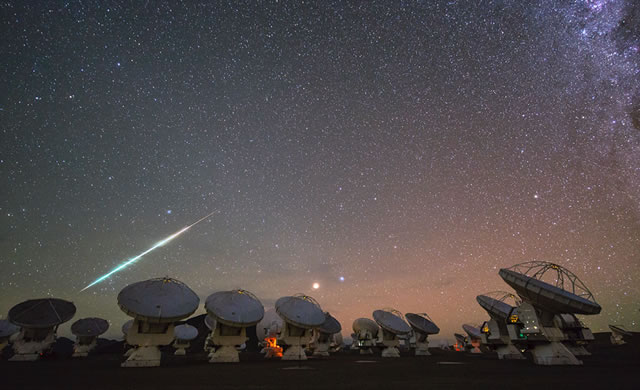
Video Credit: ESO, José Francisco Salgado, NRAO; Music: Flying Free (Jingle Punks)
Si tratta del progetto di astronomia a terra più costoso e complesso mai costruito. Cosa vedremo stasera? Il progetto Atacama Large Millimeter Array (ALMA) si compone di 66 antenne, molte delle dimensioni di una piccola casa, situato in alta quota nel deserto di Atacama nel Cile settentrionale.
ALMA osserva il cielo in luce radio ad alta frequenza, una banda di solito utilizzata solo per la comunicazione locale a causa di un notevole assorbimento di aria umida. L’atmosfera sottile e la bassa umidità sopra ALMA, tuttavia consentono di vedere in profondità nel nostro universo in modi nuovi e unici che permettono, per esempio, esplorazioni dell’universo primordiale alla ricerca delle sostanze chimiche coinvolte nella formazione stellare e l’osservazione di sistemi stellari locali per quanto riguarda i segni di dischi che formano i pianeti. Il video creato in modalità time-lapse qui sopra mostra l’attività delle quattro antenne ALMA in una notte. La Luna tramonta presto nel video, mentre tre piattaforme si orientano all’unisono. Nello sfondo le stelle ruotano continuamente verso l’alto, la fascia centrale della nostra Via Lattea segue a ruota alla fine uscendo a destra dello schermo, mentre a metà le piccole e grandi Nubi di Magellano, galassie satelliti vicine alla nostra Via Lattea, si alzano da sotto l’orizzonte. Fari di un’automobile illuminano momentaneamente le piattaforme , mentre un occasionale satellite della Terra posto in orbita, attraversa il panorama. Con l’arrivo della luce del giorno termina il video, ma non le osservazioni di Alma che solitamente proseguono per tutta la notte e tutto il giorno.
It is the most expensive and complex ground-based astronomy project ever – what will it see tonight? The Atacama Large Millimeter Array (ALMA) project consists of 66 dishes, many the size of a small house, situated in the high altitude Atacama Desert in Northern Chile.
Together, ALMA observes the skies in high-frequency radio light, a band usually used only for local communication due to considerable absorption by humid air. The thin atmosphere and low humidity above ALMA, however, enable it to see deep into our universe in new and unique ways that allow, for example, explorations of the early universe for chemicals involved in star formation, and observing local star systems for signs of disks that form planets. The above time-lapse video shows the course of four ALMA antennas over one night. The Moon sets early in the video, while three dishes repoint in unison. Background stars continually rotate up, the central band of our Milky Way Galaxy pivots around and eventually exits off to the right, while halfway through the Small and Large Magellanic Clouds – satellite galaxies near our Milky Way — rise up from below the horizon. Car headlights momentarily illuminate the dishes, while an occasional Earth-orbiting satellite crosses overhead. Daylight ends the video but not ALMA observations – which typically run both all night and all day.
Source/Continue reading → Apod.NASA.com





















